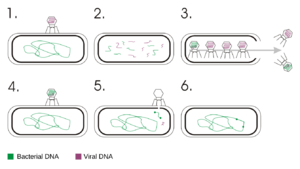Transduction (genetics) facts for kids
Transduction is a cool way that DNA moves from one bacterium to another. It happens with the help of a virus. Think of the virus as a tiny delivery truck carrying genetic information!
This process also describes how scientists use viruses to put new DNA into cells. This is a very useful tool for molecular biologists when they want to add a new gene to a cell's genome.
Contents
How Was Transduction Discovered?
In 1952, a scientist named Joshua Lederberg and his student Norton Zinder found out about transduction. They were studying bacteriophages, which are viruses that infect bacteria. They saw that these viruses could move genetic information between bacteria, specifically in a type of bacteria called Salmonella.
This discovery was a big deal! It helped explain why bacteria from different groups could quickly become resistant to the same antibiotic. It showed that bacteria don't just pass on resistance to their children; they can also share it with other bacteria around them.
How Transduction Works
When a bacteriophage virus infects a bacterial cell, it usually takes over the cell's machinery. It uses the bacterial cell to make many copies of itself. This includes making more viral DNA and the protein coats for new viruses.
Sometimes, during this process, mistakes happen. Instead of just packaging its own DNA, the virus might accidentally pick up some of the bacterial cell's DNA. When this "mistake" virus then infects a new bacterium, it can deliver the piece of DNA it picked up from the first bacterium. This new DNA can then become part of the second bacterium's own genetic material.
Why Transduction is Important
Transduction is important for a few reasons:
- Sharing Genes: It's one way bacteria can share genes, including genes that help them resist antibiotics. This means antibiotic resistance can spread quickly among different types of bacteria.
- Science Tool: Scientists use transduction in labs. They can engineer viruses to carry specific genes they want to study. Then, they use these viruses to deliver those genes into other cells. This helps them understand how genes work or even try to fix genetic problems.
Images for kids
See also
 In Spanish: Transducción (genética) para niños
In Spanish: Transducción (genética) para niños



